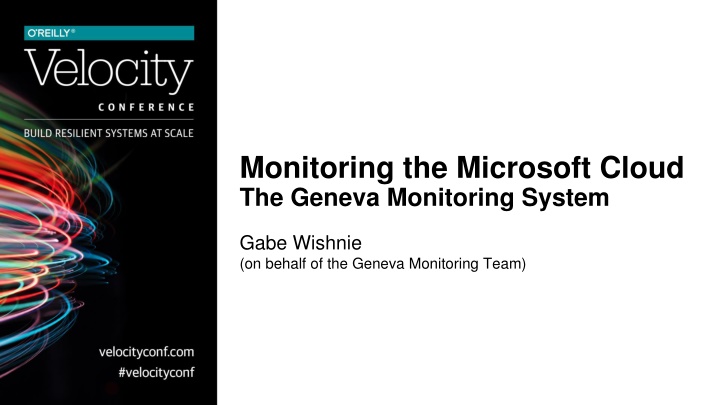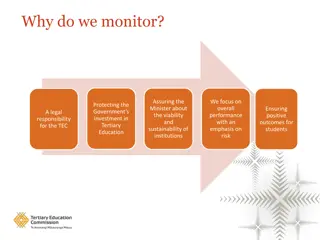Insights into Geneva Monitoring System - Managing Data Across Paths
Delve into the Geneva Monitoring System with a focus on multidimensional metrics, data classification, and the challenges of scale and data explosion. Learn about hot, warm, and cold paths for monitoring in a system processing over 2 billion metrics per minute and managing millions of clients' data.
Download Presentation

Please find below an Image/Link to download the presentation.
The content on the website is provided AS IS for your information and personal use only. It may not be sold, licensed, or shared on other websites without obtaining consent from the author.If you encounter any issues during the download, it is possible that the publisher has removed the file from their server.
You are allowed to download the files provided on this website for personal or commercial use, subject to the condition that they are used lawfully. All files are the property of their respective owners.
The content on the website is provided AS IS for your information and personal use only. It may not be sold, licensed, or shared on other websites without obtaining consent from the author.
E N D
Presentation Transcript
Monitoring the Microsoft Cloud The Geneva Monitoring System Gabe Wishnie (on behalf of the Geneva Monitoring Team)
Agenda Brief intro to Geneva Monitoring System Deep(er) dive into Geneva Metrics System (a.k.a. MDM) Questions
Geneva Data Classification Multi-Dimensional- Metric (MDM) & Health Service Alerts Hot Path (TTD<60s) Diagnostics Apps (< 5 min) HOT PATH ETW Distributing Tracing Monitoring Agent(MA) Top N Error Service Diagnostics Compute Layer API Log Search/Indexing f() WARM PATH Warm Path Data Publish SQL Azure Data Collector and Scrubber External data Cold Path COSMOS COLD PATH SQL
Wait, But I Really Want... Hot Path, Warm Path, Cold Path
Scale Is Different For Everyone Millions of clients producing data Over 2 billion metrics received and aggregated per minute after client aggregation! Over 500 million unique time series aggregated per minute Over 5 petabytes of logs ingested per day Over 5 million metric requests per minute (dashboards/views and API) Over 6 million alert combinations processed per minute 99% metric queries completed in <= 500ms
Focusing On Multidimensional Metrics (Geneva MDM) A metric is a point-in-time measure of an activity occurring or entity state within a system - Examples: - TransactionProcessed, ResponseLatency, QueryReceived, QueueDepth Dimensionality captures meta data about an activity or measure - Examples: - Locale, Market, Workflow, Flight, DataCenter Metric aggregation is compression with statistical insight over time and the population Request Latency is 867ms in market United States for Flight Alpha in datacenter Columbia.
(Some Of) The Hard Problems - Scale and data explosion - Data quality guarantees or lack thereof? - Contextual metadata - Expensive aggregation types - Crippled but available when under duress - Multitenancy (will not be covered)
Scale And Data Explosion It doesn t take a big service to generate a lot of metrics - 100 metrics - 10K users - 5 regions - 250 API calls - 10 components - 100 * 10000 * 5 * 250 * 10 = 12.5B different theoretical time series Multiply by thousands of services
Scale And Data Explosion A partitioned data funnel with client reduction LatencyMs {User:GabeW, Region:WestUS, Api:GetResponse, Value:300} Aggregation Publishing Client Publishing Client Publishing Client Publishing Client Publishing Client Publishing Client Publishing Client VIP Micro Partitioned Batching/Aggregation Frontend Server Frontend Server Frontend Server Frontend Server Frontend Server P1 P2 P3 Partitioned Batching/Aggregation Aggregator/ Batcher Aggregator/ Batcher Aggregator/ Batcher P1 P2 P3 Aggregation/Data Durability & Paging Store (Caching) Store (Caching) Store (Caching) Store (Caching) Store (Caching) For query across multiple time series, double hashing is done first on metric name then full metric tuple
Scale And Data Explosion Take advantage of the characteristics of time series metric data - Data is typically always moving forward in time - Delta-of-deltas encoding used for timestamps (T3-T2) - (T2-T1) -> 1 bit in most cases such as a minutely counter - Most metrics (modulo incidents) are relatively stable sample-over-sample - Delta encoding used for metric values (V1-V2) -> few bits depending on variance - Special case common scenarios - Many metrics are always 0 value takes 1 bit only to store since sign is not needed - Many metrics may only emit one sample per period - do not store min/max since == sum - Long values are supported, most are much smaller - Fibonacci encoding used for metric delta values 1-bit for sign + Fib(Abs( )) - Sum and Count encode to 5 bits for some data sets - 95% reduction - now multiple these savings by a billion active time series
Data Quality Strict lossiness is the enemy of low latency Avoid sustained outages time marches on and so does client publication Expect drops, capture it (and attempt to minimize it) Publishing Client Publishing Client Publishing Client Publishing Client Publishing Client Publishing Client Publishing Client VIP Frontend Server Frontend Server Frontend Server Frontend Server Frontend Server Data can be sampled Data can be dropped Data can be throttled Aggregator/ Batcher Aggregator/ Batcher Aggregator/ Batcher Store (Caching) Store (Caching) Store (Caching) Store (Caching) Store (Caching)
Data Quality The mighty canary (a.k.a. heartbeat) Used to get a steady state of active clients to an account Measure E2E ingestion to understand latency at each layer
Data Quality Same applies to query path
Contextual Metadata (a.k.a. Hinting) When dimensions on a metric increases the sparseness of known combinations increases Dimension values may only be generated for a period of time Region WestUS EastUS SouthCentralUS CentralUS EastUS2 VMID {E2C914AA-33A0-44BF-A5F8-1568254E4ACB} {A55FB923-1083-4AA5-9A77-0F34F280DC0A} {316D98D8-8C03-409A-B6C0-3839ECF7E170} {CFFC08A1-CB55-44C7-9E10-15F94E387256} {A5DFE2F7-8D01-412D-808E-584771F7CD27} {08274A3C-F7A0-4594-B3B5-09D8D9392F6C} {A267B95E-C681-4CF0-9D00-7E33FD2D166D} {B918EA85-6910-4FF8-96C9-5065B4F60A4C} {9BA5CB05-73DA-43E7-8B01-DBF27DD01B2D} {C47E5A84-973E-4CFA-B39C-87B0CA83E1C7} {9923A171-DC3D-4B15-BC2F-2F7AC528712A} {AEA776ED-D1A9-4C76-885F-E83B7DF5EFC2} {D0A77F8B-9BCA-4ACD-BA4A-9CA7E690A6D7} {6BC3ABBE-0697-455D-AD2C-440E78A80C51}
Contextual Metadata (a.k.a. Hinting) Rather contextually filter based on previous selections (implies order matters) VMID {E2C914AA-33A0-44BF-A5F8-1568254E4ACB} Region WestUS EastUS SouthCentralUS CentralUS EastUS2 {08274A3C-F7A0-4594-B3B5-09D8D9392F6C} {9923A171-DC3D-4B15-BC2F-2F7AC528712A}
Contextual Metadata (a.k.a. Hinting) Scanning can give full functionality, but slow. Indexing used for low latency query. Partitioned, in-memory index of metric metadata TSK IDX TS MD Publish metadata Aggregator/ Batcher TSK1 55 TSK1 MD {FullMetricName,DimNames,DimValues} {TSK1,StartTime,Endtime} Hints Hints Hints Hints TSK1 Example Dimension Index VAL IDX Query metadata Query Service ValA 100 IdxEntry TSK2 Single metrics with 30M+ combinations Over 360M+ combinations for single customer Receive 2500+ requests/min for single customer Custom collection that will self-optimize the number of items per record for more efficient memory utilization TSK3
Finding The Needle In The Haystack Humans cannot process millions of metrics Show me the top/bottom N with a filter Show me the top/bottom N with a filter but pivot to another metric Alerts to identify problematic series Utilize Service Fabric Actors Frontend Server Based on query criteria get candidate series and split into jobs to distribute QueryCoordinator Actor Process assigned job and reduce based on query criteria provide reduced set back QueryWorker Actor1 QueryWorker Actor2 QueryWorker ActorN
Expensive Aggregation Types Standard Sum/Min/Max/Count (Average/Rate) are relatively cheap to aggregate, store and query Percentiles and distinct count are expensive to aggregate, store and query Distinct count - HyperLogLog utilized to get statistical approximation - Sketch is constructed on client and merged throughout aggregation pipeline - Precompute common query window (i.e. 1m) for efficiency - Compute on the fly for arbitrary windows Percentiles - True collection, user defined bin intervals and automatic binning of varying technique - Currently precompute common set (50th, 90th, etc) at 1m window - Adding support to maintain histogram for arbitrary %ile and window size
Available Under Duress Big data is not new many solutions exist for various scenarios Monitoring systems are critical when the world is burning Careful dependency evaluation and isolation - Do we use storage? What if it is down? - Do we use DNS? What if it is down? - Do we use SLB VIPs? What if it is down? - Do we use a ticketing service for auth? You get the picture Core services monitor themselves using Geneva watch for circular dependencies and decide what functionality will go down with the ship and what will serve as the life boat For us, it is MDM and watchdogs/runners
Where Might You Find MDM? Initially targeted as internal monitoring solution and beginning to expand to our customers Investing in serving as backend for Azure Insights metric pipeline Application Insights utilizing for metric pipeline
Were Hiring Passionate about low latency big data problems? Enjoy working on large distributed systems? Want to enable monitoring of some of the largest services in the world? Let s talk!























